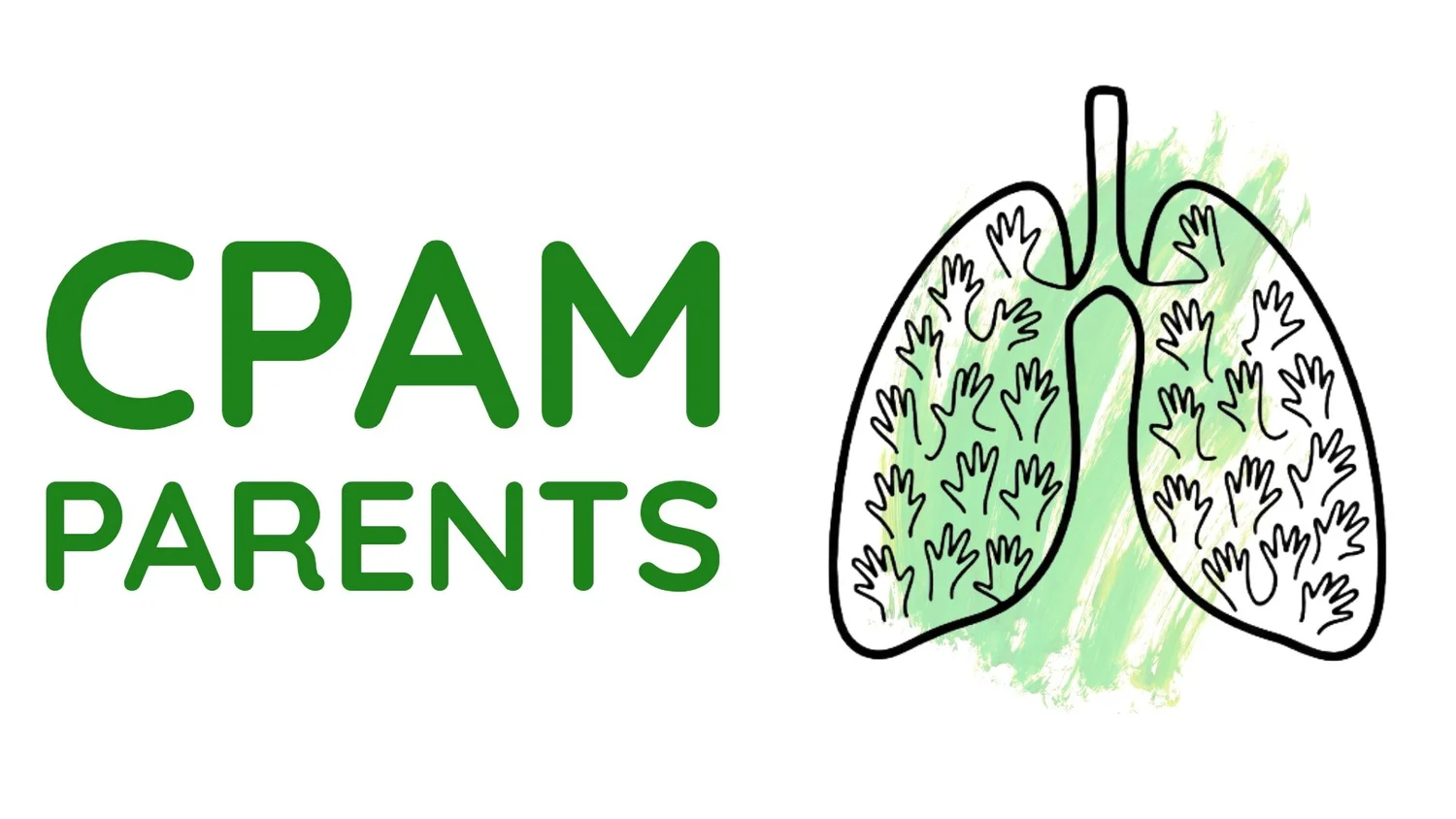Home > Education > About CLMs
About congenital lung malformations
Here you’ll find fact sheets, parent-friendly guides, and a glossary of medical terms for families learning about congenital lung malformations (CLMs). Every resource is reviewed and edited by a medical expert to ensure accuracy and clarity. Our current resources cover CPAM (congenital pulmonary airway malformation) and BPS (bronchopulmonary sequestration), and we’re actively expanding to include information on BA (bronchial atresia) and CLE (congenital lobar emphysema).
Two minute Fact Sheet
What is a congenital lung malformation?
A congenital lung malformation (CLM) is a rare condition where part of a baby’s lungs did not develop normally during pregnancy. The two most common types of lung malformation are CPAM and BPS.
What is CPAM?
CPAM (congenital pulmonary airway malformation) is an abnormal mass of lung tissue, normally affecting one lung lobe. The CPAM is part of the lungs and connected to the lung’s blood supply.
What is BPS?
Like CPAM, a BPS (bronchopulmonary sequestration) is an abnormal growth of lung tissue, but unlike CPAM, the mass is not connected to the lung’s blood supply. The BPS is connected instead to a nearby systemic vessel, normally the aorta.
What is the prognosis for someone born with a congenital lung malformation?
The prognosis is excellent. In the overwhelming majority of cases a CPAM or BPS will not affect a child’s life expectancy or quality of life. In some rarer cases, the CPAM or BPS presents more serious complications during the pregnancy or immediately after birth.
What causes CPAM or BPS?
Nobody knows for sure but CPAM or BPS is not caused by anything the mother did, or didn’t do, during pregnancy.
Why not use the term CLM?
CLM—congenital lung malformation or lesion—is being used more and more as these conditions become better studied and more frequently diagnosed. Because most people still use the term CPAM, especially at initial diagnosis, we use it broadly here so parents, family members, and healthcare professionals can find us easily online.
Are there other types of CLM?
Bronchogenic cysts, CLE (congenital lobar emphysema), and bronchial atresia are rarer types of congenital lung malformations. CPAM Parents is working on expanding our resources to cover these conditions too.
How common is CPAM or BPS?
Congenital lung malformations altogether are thought to impact 1 in 2,500 live births.
-

Parent Guides
Practical, parent-friendly guides to help you navigate a congenital lung malformation diagnosis
-

Glossary
A parent-focused glossary that explains medical terms and concepts related to congenital lung malformations in clear, everyday language
-

Fact Sheets
Quick easy-to-read fact sheets to bring to appointments or share with your support network
Tell me quickly about…
-
The majority of babies with a congenital lung malformation are asymptomatic at birth, which means they breathe normally and do not need support.
In about 10% of cases a baby with a lung malformation will be symptomatic meaning they do need help to breathe.
Symptomatic babies may be given high flow air, which is a non-invasive type of breathing support that delivers a high flow rate of air and oxygen through the nose. If this is not enough they will be put on a CPAP machine which is a non-invasive type of breathing support that delivers a constant pressure of air and oxygen through a sealed cannula in the nose.
In rare cases where the baby is really struggling to breathe and cannot get enough oxygen from non-invasive methods, the medical team may decide to intubate. Intubation is an invasive type of breathing support where a tube is inserted into the trachea (windpipe) so air and oxygen (and sometimes medication) can be delivered directly into the baby’s lungs.
-
At the initial diagnosis, which normally happens during pregnancy at the twenty week ultrasound, the vast majority of parents are told that their baby has a “CPAM”. A more specific diagnosis is often made later after more advanced imaging, like an MRI or CT, or even after surgery. Because most people use the term CPAM, we use it broadly here so parents, family members, and healthcare professionals can find us easily online.
The term CLM—congenital lung malformation—is being used more and more as these conditions become better studied and more frequently diagnosed.
CPAM - congenital pulmonary lung malformation
BPS - bronchopulmonary sequestrationCLE – congenital lobar emphysema
CLM - congenital lung malformation
CCAM - congenital cystic adenoid malformation (the old term for CPAM)
Hybrid lesion - a combination of, usually, CPAM and BPS
-
Nobody knows exactly, but being diagnosed with a congenital lung malformation is still uncommon, even with technological advances leading to much better detection rates. Congenital lung malformations altogether are thought to impact 1 in 2,500 live births.
-
For the majority of parents, the biggest change to your pregnancy will be how often you now have to come in for ultrasounds. Your medical team will want to monitor the lung malformation closely. Most moms will come in weekly or every two weeks. In higher risk cases, which are rare, you may need to come in twice a week. The ultrasound tech and the MFM doctor will be looking closely for:
1) changes in the size of the lung mass
2) any signs of fluid around your baby’s tissues and/or organs
3) any signs of mass effects (if the lung mass is pushing on other structures in the chest)
-
Prenatal interventions are rare. In the majority of cases the CPAM or BPS will not grow fast enough or large enough to pose a risk during pregnancy. In high risk cases, any intervention depends on the type of mass, how it has changed so far, and whether there are other complications. For solid/microcystic CPAM and BPS lesions, a course of steroids may be given to try and shrink or stall the growth of the mass. For large macrocystic CPAM or hybrid lesions, a procedure called a thoracoamniotic shunt can be used to try and shrink the mass. In extremely rare cases fetal surgery or the EXIT procedure may be carried out but these are rarely considered and carry significant risks.
-
This is where the lung malformation pushes other organs in the chest, so they shift from their normal position, e.g. the lung mass pushes the heart to the other side of your baby’s chest. If this happens (it is not uncommon) your medical team will monitor the lung malformation closely. In the majority of cases, any mediastinal shift resolves during the third trimester when the lung mass shrinks or stalls in size.
-
CVR stands for “CPAM volume ratio”. It is a calculation used to estimate the size of the lung mass in relation to the size of the baby or child. A CVR of less than 1.6 is considered lower risk for complications. It is not uncommon for the CVR (i.e. the lung lesion) to grow in the 2nd half of the 2nd trimester before shrinking or plateauing in the 3rd trimester.
Remember that the CVR is an estimate that is not 100% accurate: it will fluctuate depending on how the baby is lying, where the cursor is when the measurements are taken, and who the tech is that day.
-
These two terms are used interchangeably.
-
Nobody knows for sure but a lung malformation is not caused by anything the mother did, or didn’t do, during pregnancy.
FAQs
Where do you source your information?
We draw on peer-reviewed medical research, trusted clinical guidelines, and leading hospital resources.
Who writes the content?
Everything in the Education Hub is written by parents with lived experience of congenital lung malformations.
How is the information checked?
Every piece of content in the Education Hub is reviewed and edited by a highly qualified medical expert who works with congenital lung malformations. This ensures all our information is as accurate and clear as possible. You can always see who reviewed and edited a certain piece by checking out the byline at the top of the page. Everything in the Education Hub is then further reviewed every year to make sure it keeps up with current research.
Why this approach?
Because families deserve information that is both medically sound and easy to understand, grounded in both expertise and experience.

